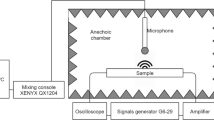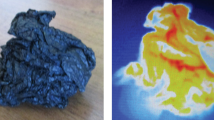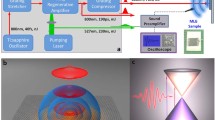Abstract
Purpose
A graphene thermophone requires a substrate to support its extremely thin structure. It is essential to determine the characteristic parameters and selection principles of substrates and gases in both low- and high-frequency ranges for improving the sound pressure of graphene thermophones.
Methods
First, the theoretical models for thermoacoustic emission from a graphene on a substrate are established. Analytical expressions of the sound pressure are derived based on analysis of the thermal piston sound source. Then, experimental results of graphene on various transparent substrates are presented to verify the theoretical models. Finally, performance parameters of substrates and gases are summarized and analyzed including the thermal effusivity of substrates, the heat capacity per unit area of substrates, the thermal effusivity of gases and the heat capacity of gases.
Results
The theoretical predictions agree well with the experimental results. At high frequencies, a lower thermal effusivity of substrates leads to a higher sound pressure. While at low frequencies, the heat capacity per unit area can be selected as the evaluation parameter for substrates. Substrates with a lower heat capacity show better acoustic performances. The performance evaluation parameters of ambient gases can be concluded as the thermal effusivity and the heat capacity for thermoacoustic emission at both high and low frequencies. For gases, the higher thermal effusivity combined with the lower heat capacity is better to achieve a higher sound pressure.
Conclusions
The theoretical models are applicable to on-substrate thermophones and the results are useful to the optimization of the gas/graphene/substrate multilayer structures.










Similar content being viewed by others
References
Preece WH (1880) I. On some thermal effects of electric currents. Proc R Soc Lond 30:408–411. https://doi.org/10.1098/rspl.1879.0139
Braun F (1898) Notiz über thermophonie. Ann Phys 301:358–360. https://doi.org/10.1002/andp.18983010609
Arnold HD, Crandall IB (1917) The thermophone as a precision source of sound. Phys Rev 10:22–38. https://doi.org/10.1103/PhysRev.10.22
Tong LH, Lai SK, Lim CW (2017) Broadband signal response of thermo-acoustic devices and its applications. J Acoust Soc Am 141:2430–2439. https://doi.org/10.1121/1.4979667
Hu HP, Zhu T, Xu J (2010) Model for thermoacoustic emission from solids. Appl Phys Lett 96:214101. https://doi.org/10.1063/1.3435429
Venkatasubramanian R (2010) Nanothermal trumpets. Nature 463:619. https://doi.org/10.1038/463619a
Tian H, Yang Y, Li C, Mi WT, Mohammad AM, Ren TL (2015) A flexible, transparent and ultrathin single-layer graphene earphone. RSC Adv 5:17366. https://doi.org/10.1039/C4RA16047A
Shinoda H, Nakajima T, Ueno K et al (1999) Thermally induced ultrasonic emission from porous silicon. Nature 400:853–855. https://doi.org/10.1038/23664
Xiao L, Chen Z, Feng C, Liu L, Bai ZQ, Wang Y, Qian L, Zhang YY, Li QQ, Jiang KL, Fan SS (2008) Flexible, stretchable, transparent carbon nanotube thin film loudspeakers. Nano Lett 8:4539–4545. https://doi.org/10.1021/nl802750z
Tian H, Ren TL, Xie D, Wang YF, Zhou CJ, Feng TT, Fu D, Yang Y, Peng PG, Wang LG, Liu LT (2011) Graphene-on-paper sound source devices. ACS Nano 5:4878–4885. https://doi.org/10.1021/nn2009535
Mao YD, Lim CW, Li TY (2019) Multi-field coupling thermo-acoustic radiation using free-standing nano-thin films in a static magnetic field. J Therm Stresses 42:769–786. https://doi.org/10.1080/01495739.2019.1601539
Mao YD, Lim CW, Li TY, Xiang Z (2021) Thermo-magnetic induced monodirectional periodic acoustic emission from free-standing nano-thin film. J Sound Vib 490:115569. https://doi.org/10.1016/j.jsv.2020.115569
Tian H, Xie D, Yang Y, Ren TL, Wang YF, Zhou CJ, Peng PG, Wang LG, Liu LT (2012) Single-layer graphene sound-emitting devices: experiments and modeling. Nanoscale 4:2272–2277. https://doi.org/10.1039/C2NR11572G
Yan JW, Zhang W (2021) An atomistic-continuum multiscale approach to determine the exact thickness and bending rigidity of monolayer graphene. J Sound Vib 514:116464. https://doi.org/10.1016/j.jsv.2021.116464
Suk JW, Kirk K, Hao Y, Hall NA, Ruoff RS (2012) Thermoacoustic sound generation from monolayer graphene for transparent and flexible sound sources. Adv Mater 24:6342–6347. https://doi.org/10.1002/adma.201201782
Yu YM, Lim CW (2013) Nonlinear constitutive model for axisymmetric bending of annular graphene-like nanoplate with gradient elasticity enhancement effects. J Eng Mech 139:1025–1035. https://doi.org/10.1061/(ASCE)EM.1943-7889.0000625
Luo Q, Li C, Li S (2021) Transverse free vibration of axisymmetric functionally graded circular nanoplates with radial loads. J Vib Eng Technol 9:1253–1268. https://doi.org/10.1007/s42417-021-00294-x
Yan JW, Lai SK, He LH (2019) Nonlinear dynamic behavior of single-layer graphene under uniformly distributed loads. Compos B Eng 165:473–490. https://doi.org/10.1016/j.compositesb.2019.01.072
Liu YS, Tong LH, Lai SK (2018) Thermo-acoustics generated by periodically heated thin line array. J Sound Vib 427:28–40. https://doi.org/10.1016/j.jsv.2018.04.034
Lim CW, Tong LH, Li YC (2013) Theory of suspended carbon nanotube thinfilm as a thermal-acoustic source. J Sound Vib 332:5451–5461. https://doi.org/10.1016/j.jsv.2013.05.020
McDonald FA, Wetsel GCJ (1978) Generalized theory of the photoacoustic effect. J Appl Phys 49:2313–2322. https://doi.org/10.1063/1.325116
Bian AH, Li S, Xing QH, Huang X, Fan XL, Li C (2017) Thermo-acoustic theory of graphene films considering heat transfer of substrate materials. Acta Acustica 42:755–761. https://doi.org/10.15949/j.cnki.0371-0025.2017.06.015 (In Chinese)
Hu HP, Wang YD, Wang ZD (2012) Wideband flat frequency response of thermo-acoustic emission. J Phys D Appl Phys 45:345401. https://doi.org/10.1088/0022-3727/45/34/345401
Gao F, Kishor R, Feng XH, Liu SY, Ding R, Zhang RC, Zheng YJ (2017) An analytical study of photoacoustic and thermoacoustic generation efficiency towards contrast agent and film design optimization. Photoacoustics 7:1–11. https://doi.org/10.1016/j.pacs.2017.05.001
Wang DB, Xin JH, He XY, Zhang D (2019) Research on sound pressure level of graphene loudspeaker with AC and AC/DC excitation. Jpn J Appl Phys 58:116502. https://doi.org/10.7567/1347-4065/ab4692
Kim CS, Hong SK, Lee JM, Kang DS, Cho BJ, Choi JW (2016) Free-standing graphene thermophone on a polymer-mesh substrate. Small 12:185–189. https://doi.org/10.1002/smll.201501673
Xing QH, Li S, Fan XL, Bian AH, Cao SJ, Li C (2017) Influential factors on thermoacoustic efficiency of multilayered graphene film loudspeakers for optimal design. J Appl Phys 122:125107. https://doi.org/10.1063/1.5004124
Xiao L, Liu P, Liu L, Li QQ, Feng ZH, Fan SS, Jiang KL (2011) High frequency response of carbon nanotube thin film speaker in gases. J Appl Phys 110:084311. https://doi.org/10.1063/1.3651374
Aliev AE, Lima MD, Fang SL, Baughman RH (2010) Underwater sound generation using carbon nanotube projectors. Nano Lett 10:2374–2380. https://doi.org/10.1021/nl100235n
Aliev AE, Gartstein YN, Baughman RH (2013) Increasing the efficiency of thermoacoustic carbon nanotube sound projectors. Nanotechnology 24:235501. https://doi.org/10.1088/0957-4484/24/23/235501
Asadzadeh SS, Moosavi A, Huynh C, Saleki O (2015) Thermo acoustic study of carbon nanotubes in near and far field: theory, simulation, and experiment. J Appl Phys 117:095101. https://doi.org/10.1063/1.4914049
Rosencwaig A, Gersho A (1976) Theory of the photoacoustic effect with solids. J Appl Phys 47:64–69. https://doi.org/10.1063/1.322296
Boullosa RR, Santillan AO (2004) Ultrasound radiation from simple thermoacoustic transducers. Acta Acust Acust 90(2):277–284
Zhou ZH, Xu W, Tong ZZ, Lim CW, Xu XS (2019) Theory and modeling of multi-layer carbon nanotube thin film thermoacoustic transducer. Appl Therm Eng 150:143–149. https://doi.org/10.1016/j.applthermaleng.2019.01.001
Du GH, Zhu ZM, Gong XF (2012) Radiation of circular piston on infinite barrier plate. Fundamentals of acoustics, 3rd edn. Nanjing University Press, Nanjing, pp 223–225
Vesterinen V, Niskanen AO, Hassel J, Helisto P (2010) Fundamental efficiency of nanothermophones: modeling and experiments. Nano Lett 10:5020–5024. https://doi.org/10.1021/nl1031869
Mao YD, Lim CW, Li TY (2019) Thermo-acoustic radiation of free-standing nano-thin film in viscous fluids. Int J Eng Sci 139:11–23. https://doi.org/10.1016/j.ijengsci.2019.03.002
Tong LH, Lim CW, Lai SK, Li YC (2015) Gap separation effect on thermoacoustic wave generation by heated suspended CNT nano-thinfilm. Appl Therm Eng 86:135–142. https://doi.org/10.1016/j.applthermaleng.2015.04.031
Guiraud P, Giordano S, Bou-Matar O, Pernod P, Lardat R (2019) Multilayer modeling of thermoacoustic sound generation for thermophone analysis and design. J Sound Vib 455:275–298. https://doi.org/10.1016/j.jsv.2019.05.001
Acknowledgements
This work was supported by National Natural Science Foundation of China (Grant Nos. 51875374 and 11972240).
Author information
Authors and Affiliations
Corresponding author
Ethics declarations
Conflict of Interest
The authors declared no potential conflicts of interest with respect to the research, authorship, and/or publication of this article.
Additional information
Publisher's Note
Springer Nature remains neutral with regard to jurisdictional claims in published maps and institutional affiliations.
Rights and permissions
About this article
Cite this article
Qiu, X., Li, S., Li, C. et al. Characteristic Parameters and Selection Principles of Substrates and Gases for Graphene Thermophones. J. Vib. Eng. Technol. 10, 1111–1119 (2022). https://doi.org/10.1007/s42417-022-00432-z
Received:
Revised:
Accepted:
Published:
Issue Date:
DOI: https://doi.org/10.1007/s42417-022-00432-z




